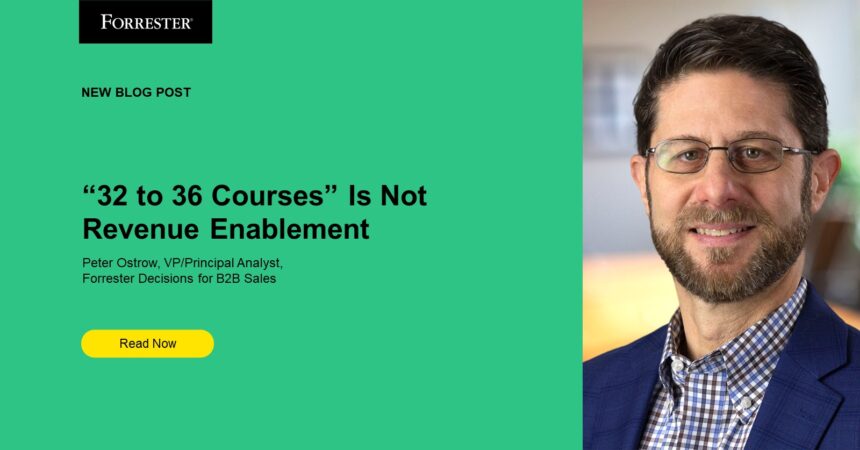True story: Years ago, a Forrester revenue enablement customer meeting was unexpectedly joined by a new voice, an individual whose exact role was unclear to our team beyond “they’ve joined us to help up-level our B2B sales onboarding.” Our initial excitement at undertaking a significant, new collaborative workstream was, however, quickly mitigated when the individual declared to us, “I’ve come to the conclusion that what this sales organization needs for onboarding excellence is 32 to 36 new courses.” Yikes. This was already starting to sound like a serious case of sales inflictment.
Show Me The Data
Industry analysts are paid to be honest — brutally, if necessary — but we found a way to more subtly maneuver the conversation toward “Why do you believe this? What are you solving for?” The answer:
- Sales learning is very ad hoc, not organized.
- Sales learning is very manager-driven and therefore inconsistent.
- There is a huge disparity among sellers skills-wise.
OK, I thought, I can work with this; these are 100% addressable issues. Then I made the mistake of asking, “What kind of data have you gathered to arrive at this conclusion?” They answered, “I’ve been watching salespeople for years, and it’s always the same. They never want to learn, they skip classes, and we need to force noncompliers to take remedial courses.”
Whoa.
Subsequent non-enablement research revealed where this originated: The individual was a contracted instructional designer, likely compensated by the course, who had clearly never sold anything nor enabled those who do. Their motivation was understandable, albeit misaligned both with the challenges we were hired to address, and with instructional design best practices: “determining the state and needs of the learner, defining the end goal of instruction, and creating some ‘intervention’ to assist in the transition.” This felt more like the needs of the course designer and an end goal of large invoices.
In real time, however, we were able to shift the conversation toward a data-driven discovery of their true gaps and offer solutions, utilizing best practices in sales hiring, onboarding, and everboarding to discuss the company’s overall sales talent and competency management strategy. We agreed to start with rep- and manager-level sales activity studies to collect objective, current data about seller productivity. We helped the organization correlate those results with team performance results, enabling them to best determine how formal (or draconian) they should behave around assessing and certifying various role-specific competencies — all of which, fortunately, they soon did.
The Right Way To Determine Sales Learning Volume — And Timing
None of this is to say that formal courseware, and plenty of it, isn’t valuable to B2B revenue teams, nor that 30 or 300 readiness offerings are inappropriate. Indeed, our research shows that high-performing sales organizations provide 59% more general training, requiring 15% more field observations before formal certification, and hold new reps back 29% longer before allowing 1:1 buyer interactions. Assuming that the instructional design “why?” question mentioned above is more objectively addressed in your organization, think about learning structures around IF it’s necessary, WHO should learn, WHEN it’s optimally delivered, and HOW to provide it most effectively:
- IF: For both new and tenured sellers, don’t insult them, waste their time, and diminish their sense of engagement by reteaching something they already know. High-performing B2B sellers are 111% more likely to indicate that “I was able to skip some aspects of onboarding because of my professional experience.” Think of an equivalent to AP testing, in which high school seniors can demonstrate enough topical competence to opt out of relevant first-year university courses.
- WHO: High-performing sales teams are 29% more likely to “only train those sellers to whom the new learning directly applies.” The worst move a revenue enablement team can make is forcing square-peg-round-hole learning on to folks who don’t have active, current sales motions that necessitate them. This is similar to …
- WHEN: Adopting best practices in activity-based learning, in which we don’t deliver learning when it’s convenient to us but only when it fits into the context of the one thing that matters to a B2B seller: their current deals and opportunities. The easiest way to understand this? Analyze your current best performers.
- HOW: Leverage the Continuous Learning Framework to deliver a “tell, show, do, reinforce, own” cadence of adult learning, specifically for revenue team members. It all but guarantees that they’ll be stronger at knowing what they need to know, when the time is right, and how to execute their new motions beautifully.








